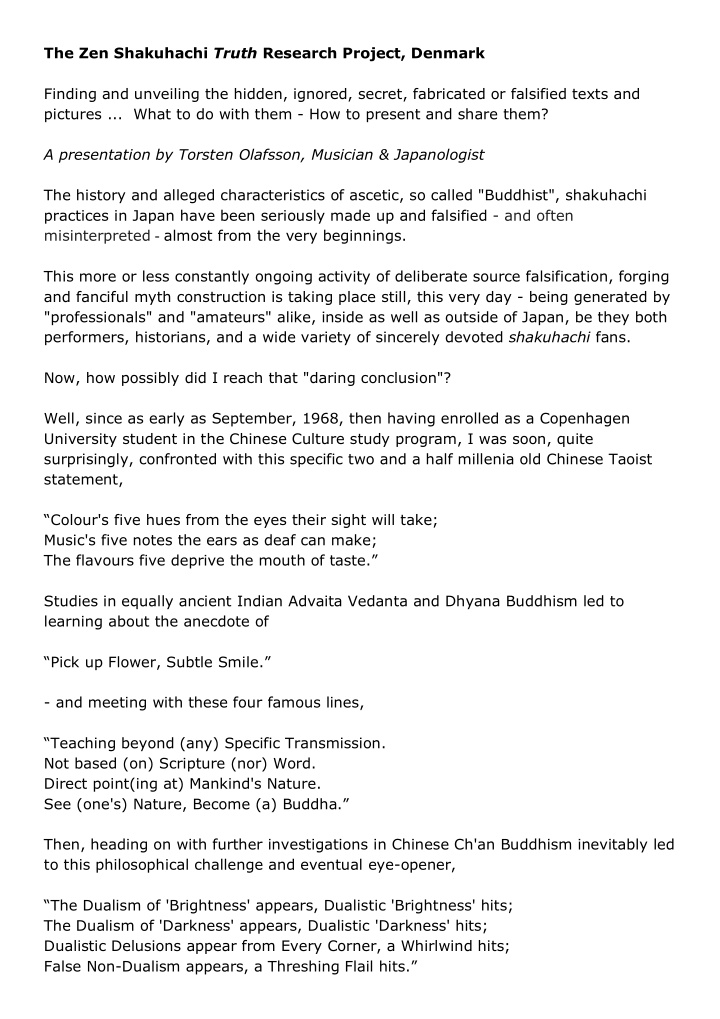



The Zen Shakuhachi Truth Research Project, Denmark Finding and unveiling the hidden, ignored, secret, fabricated or falsified texts and pictures ... What to do with them - How to present and share them? A presentation by Torsten Olafsson, Musician & Japanologist The history and alleged characteristics of ascetic, so called "Buddhist", shakuhachi practices in Japan have been seriously made up and falsified - and often misinterpreted - almost from the very beginnings. This more or less constantly ongoing activity of deliberate source falsification, forging and fanciful myth construction is taking place still, this very day - being generated by "professionals" and "amateurs" alike, inside as well as outside of Japan, be they both performers, historians, and a wide variety of sincerely devoted shakuhachi fans. Now, how possibly did I reach that "daring conclusion"? Well, since as early as September, 1968, then having enrolled as a Copenhagen University student in the Chinese Culture study program, I was soon, quite surprisingly, confronted with this specific two and a half millenia old Chinese Taoist statement, “Colour's five hues from the eyes their sight will take; Music's five notes the ears as deaf can make; The flavours five deprive the mouth of taste.” Studies in equally ancient Indian Advaita Vedanta and Dhyana Buddhism led to learning about the anecdote of “Pick up Flower, Subtle Smile.” - and meeting with these four famous lines, “Teaching beyond (any) Specific Transmission. Not based (on) Scripture (nor) Word. Direct point(ing at) Mankind's Nature. See (one's) Nature, Become (a) Buddha.” Then, heading on with further investigations in Chinese Ch'an Buddhism inevitably led to this philosophical challenge and eventual eye-opener, “The Dualism of 'Brightness' appears, Dualistic 'Brightness' hits; The Dualism of 'Darkness' appears, Dualistic 'Darkness' hits; Dualistic Delusions appear from Every Corner, a Whirlwind hits; False Non-Dualism appears, a Threshing Flail hits.”
Last, but not least, this particular Medieval Japanese shakuhachi credo appeared, “Cut off [your] Dualism, and the Essence of the Shakuhassun transcends Past and Present. That one Melody [or, Music] blowing forth of a Mind of Impermanence [Muj ō shin no ik-kyoku] , surpasses the Deepest of Friendships - beyond Limit.” In other words: This, I believe, is what so called "ascetic shakuhachi practice" is plainly and indisputably all about: The Realization of the Truly Non-dual and Non-delusioned Nature of Ultimate Reality :-) Moreover, critical, un-biased text studies appear to show that there were definitely no komus ō in existence and practice before c. 1640 at the earliest, and that the so called "Fuke Sect" was never officially approved by the supreme sh ō gunal authorities of Edo Period Japan in capacity as “genuine, full-fledged Zen sect”. See you in Vejle :-) Cheers - Torsten O. www.zen-shakuhachi.dk
1791. Woodcut print of a komus ō receiving alms. In: 'Yamato meisho zue', 大和名所図絵 , "Pictures from Famous Places in Japan". Illustration by Takehara Shinkei, 1791. By courtesy of The National Museum of Denmark, Department of Ethnography, Copenhagen. Photo reproduction by John Lee.
Recommend
More recommend